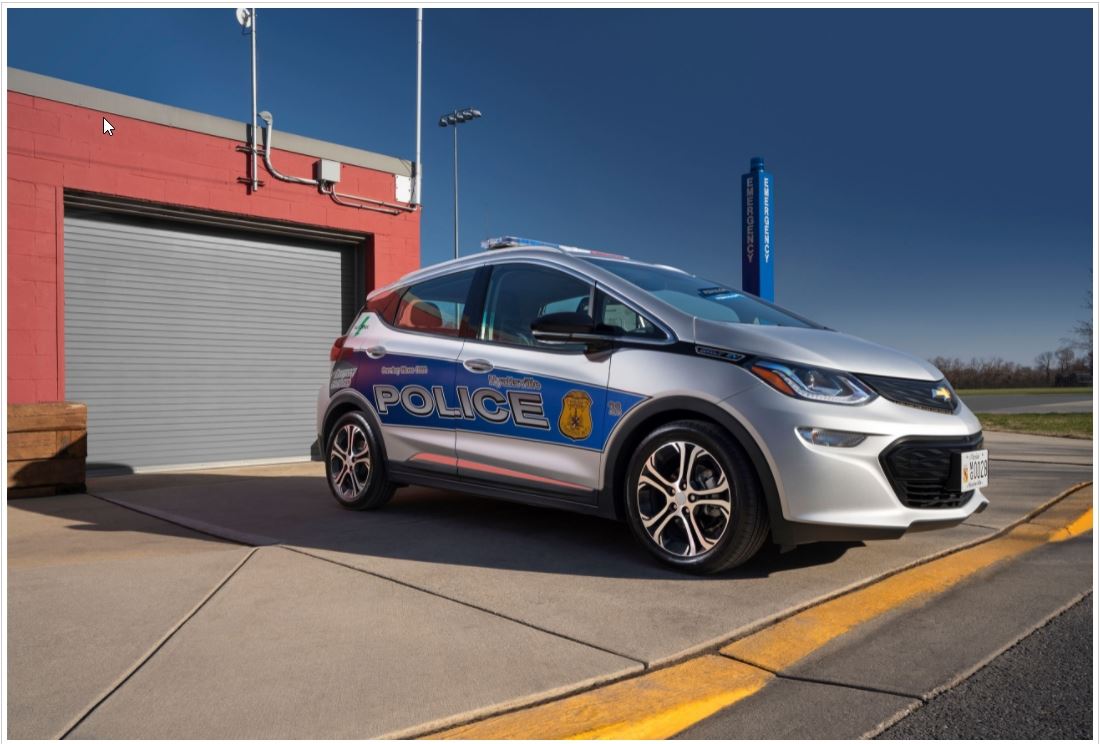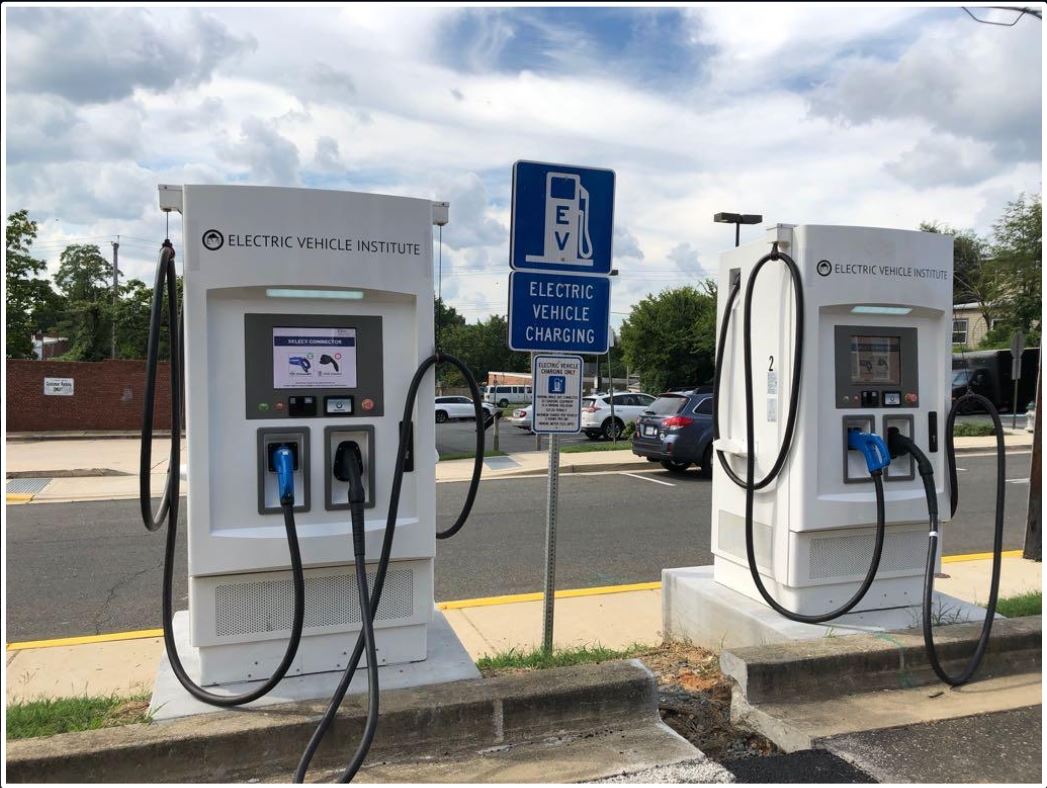Contact Us
To provide feedback on the Community Policing Dispatch, e-mail the editorial board at CPDispatch@usdoj.gov.
To obtain details on COPS Office programs, publications, and resources, contact the COPS Office Response Center at 800-421-6770 or AskCopsRC@usdoj.gov

U.S. Department of Justice
Office of Community Oriented Policing Services
Washington, DC 20530
As gasoline prices rise, an increasing number of police departments are adding electric vehicles (EV) and hybrid electric vehicles (HEV) to their fleets. Though purchasing an EV or HEV would seem to be a “no-brainer” for both financial and environmental reasons, there are pros and cons for doing so, most of which are related to their intended use.
Charging Requirements
 Powered by lithium batteries, EVs need to be recharged at intervals that vary according to the size of the battery and speed of the charger.
Powered by lithium batteries, EVs need to be recharged at intervals that vary according to the size of the battery and speed of the charger.
Most agencies use the 240 Volt Level 2 chargers, which can refill a large battery that is half full up to 80 percent in a few hours. Direct current (DC) chargers are much faster than regular alternating current (AC) chargers and can take less than 20 minutes to charge an electric car up to 80 percent.
Says Todd Bertram, chief of the Bargersville (Indiana) Police Department, "We’ve been using Tesla EV’s as patrol cars since 2019, and charging has never been a problem. But this is because our typical patrol shift is 80 to 150 miles, which is easily covered by a fully charged car.
"And we require that all cars be recharged when they drop to 50 percent power, which is the same requirement for gas fueled vehicles, which must be refilled at half a tank.
"All cars have to be up to 80 percent before they go out, and powering up our Teslas from 50 to 80 percent with their fast chargers takes about 20 to 30 minutes. Our officers can do that while they are back at the department doing paperwork."
But there is a difference between the mileage and the operating time an EV can get from one charge, because most battery power is used by the drive motor. When the car is stationary, even if it’s using lights, heat, or air conditioning, it consumes much less power.
Said Chief Bertram, "I’d recommend electric vehicles for most police departments. But not as patrol cars for state police who may pursue 10 to 15 cars at high speed every day. They would use a lot of battery power and be unable to recharge often enough."
Mileage and Time Range

Hyattsville (Maryland) Police Department
Though the average EV can travel about 250 miles on a charge today, there are others that can go much farther, and it is predicted that their range will be up to 500 miles in the near future.
But though this range may work for vehicles that stay at the station for an extended time between shifts, it would be a problem if officers share cars, switching off after their shifts.
This is the case for the Hyattsville (Maryland) Police Department (HPD), which operates a fleet that includes a fully-electric 2017 Chevrolet Bolt and three Ford hybrids. Said HPD Patrol Commander Lieutenant Zachary Nemser, “The Bolt has about 230-mile range, which, as far as administrative capacity goes, is fine. And that is what it is used for.
"But if it takes 30 mins to two hours to fully charge a car, this doesn’t work for our patrol officers who are going from call to call on 12-hour shifts. Our guys don’t come into headquarters to do their paperwork; they write reports in the field. So there is no time for extra charging."
Major Mike McNab of the Spokane City (Washington) Police Department, which has Tesla cruisers, agrees. “If the car is assigned to one officer, that may work. But we do hot seating in our patrol vehicles, meaning that they’re shared. So each car runs almost 24 hours a day."
For this reason, Spokane transferred use of their EV cruisers to detectives. However, they are considering hybrid cars as cruisers, and are now testing Ford Interceptors.
Fuel and Maintenance Savings

Hyattsville (Maryland) Police Department
Though purchase price plus additional upfitting costs may be high, the long-term fuel and maintenance savings can greatly offset it.
According to Bertram, his department has been saving up to $6,700 on fuel costs every year on each of Bargersville’s five electric patrol cars, the first of which they purchased in 2019. And these savings are increasing as gasoline prices rise.
Though HVEs require gas as well as electric power, Nemser has found that HPD’s Ford Fusion and Ford Interceptor conserve fuel. What’s more, the light bar, heat, air conditioning and electronics operate for long periods on battery power if an officer has to stay on site for hours at a time during an accident investigation or traffic light outage.
In addition to fuel savings, EVs and HEVs require less maintenance. Lieutenant Nemser estimates the savings on brake replacements and oil changes, which are not necessary on their Chevy Bolt, have added up to about $600 per year.
"Since we got it in 2017, the only thing we’ve replaced is the 12-volt battery, the one that runs the accessories. We’ve also rotated the tires. Overall, we’ve saved about 75 percent on energy and maintenance costs."
As for battery lifespan, Consumer Reports (CR) estimates the average EV battery's lifespan to be at around 200,000 miles. In the same February 2020 report, CR also stated that EVs are generally more mechanically reliable than gasoline models because there are fewer parts.
Upfitting and Other Costs
But there are costs to upfitting these cars with dashboard electronics, sirens, lights, a push bar, and other necessities. Even purpose-built electric police vehicles lack some necessary components.
Said Major McNab, “I think it would be valuable for other departments to understand the increased cost due to custom fabrication for upfitting civilian designed vehicles for police work. We experienced a 100 percent increase in upfitting costs for our Teslas.
"We also ran into problems installing the in-car patrol computer because it competes with the vehicle control screen for space.
"It’s a significant factor that can offset the total cost calculation. Though EVs typically cost less than internal combustion vehicles, upfitting costs results in the EV being the same or greater price than an ICE vehicle."
Another cost consideration is charging stations, both the number required and the power level. Fast chargers can be very expensive. But the HPD’s chargers were paid for by a grant from the Maryland Energy Administration, and other agencies may be able to find similar funding.
Pursuit Capability and Safety
Said Bertram, "Our EV can go from zero to 60 in 5.2 seconds, and the top speed is 140 mph. Even if we’re chasing somebody going 100 miles mph, we’re going to catch them, and it’s likely to be a shorter pursuit because we’re so much faster."
EV and HEV cars are also very safe. Like all light duty cars and trucks sold in the United States, they must meet the Federal Motor Vehicle Safety Standards, which require an extensive testing process. EV battery packs must meet their own testing standards, which require safety features that shut down the electrical system when they detect a collision or short circuit.
These cars also have 5-star safety ratings from the National Highway Traffic Safety Administration, which rates them on how well they protect occupants in frontal and side as well as rollover crashes.
But there are other safety considerations as well. According to McNab, SPD’s Tesla model is not situationally safe in some circumstances.
"Approaching a call, you may want to drive unseen and park silently, but the settings don’t allow you to drive without lights. The car beeps when you lock it too, but you can turn that feature off," he said.
All three officers agreed that EVs and HEVs are definitely the future. But as McNab said, "We need to take a very careful approach, taking time to do research, test the cars, and build the charging infrastructure too.
"We wanted to purchase a fast charger, for instance, and the local electric company agreed to help us. But then we found out the local grid wouldn’t support it."
Faye C. Elkins
Sr. Technical Writer
COPS Office
Subscribe to Email Updates
To sign up for monthly updates or to access your subscriber preferences, please enter your email address in the Subscribe box.






